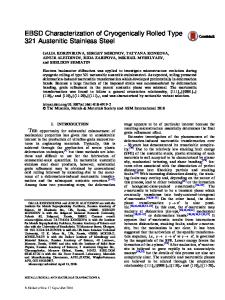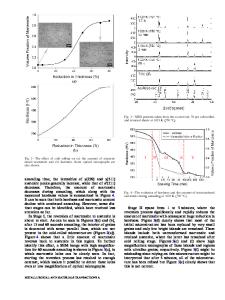Microstructural Characterization of Rapidly Solidified Type 304 Stainless Steel
- PDF / 800,143 Bytes
- 4 Pages / 417.6 x 639 pts Page_size
- 67 Downloads / 387 Views
MICROSTRUCTURAL CHARACTERIZATION OF RAPIDLY SOLIDIFIED TYPE 304 STAINLESS STEEL R. N. Wright, J. E. Flinn, and G. E. Korth Idaho National Engineering Laboratory, EG&G Idaho, Inc., Idaho Falls, ID 83415 ABSTRACT The microstructures of rapidly solidified Type 304 stainless steel powders produced by vacuum gas (VGA) and centrifugal atomization (CA) have been examined. The solidification morphology and phase distribution have been characterized using optical and scanning electron microscopy, and the relative amounts of ferrite and austenite have been quantified using x-ray diffraction. Most CA powder particles contain both fcc and bcc phases, with the bcc phase predominating at small particle sizes and the fcc phase at large particle sizes. The VGA powder generally contains less ferrite, with very little dependence on the particle size. The ferrite was metastable and transforms to austenite on annealing at 900*C. INTRODUCTION The potential advantages of rapid solidification processing (RSP), refined microstructures, improved chemical homogeneity, and retention of metastable phases, have been the subject of extensive research since the discovery of metallic glasses in 1960 [1]. To achieve the necessary heat transfer to obtain high cooling rates, the products formed must have very high surface to volume ratios, e.g., ribbons, flakes or powders. Difficulty arises in consolidating the particulates into monolithic forms suitable for engineering applications without losing the benefits of RSP. With the exception of dynamic consolidation [2], the methods currently under development for producing monolithic forms (e.g., hot isostatic pressing or hot extrusion) involve exposing the RSP material to temperatures on the order of half the melting point or above for extended periods of time. The effect of thermal or thermal-mechanical processing on the microstructure of RSP materials is not currently well understood. This paper presents the results of a study of the microstructure and response to annealing of RSP Type 304 stainless steel powders processed by centrifugal and vacuum gas atomization. The goal of this work is to understand the development of the microstructural features of the rapidly solidified powders and the relationship of the powder characteristics to processing variables. Detailed characterization of the powders, and their response to heat treating, also provides a reference state for consolidation studies and aids in developing processes to produce monolithic forms which retain desirable RSP properties. EXPERIMENTAL PROCEDURE Rapidly solidified Type 304 SS powder made by the CA process was obtained from Pratt and Whitney Government Products Division, West Palm Beach, FL. Powder produced by vacuum gas atomization (VGA) was obtained from Homogeneous Metals Inc., Clayville, NY. Both powders were made from ingots provided by the suppliers; the chemical composition of the powders is given in Table I. The powders were classified into nine size fractions from -250 pm to -10 pm by screening. The relative volume fractions
Data Loading...











